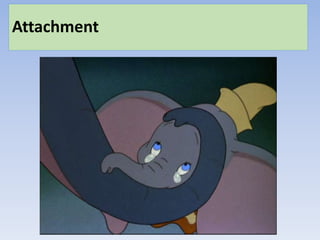
Mod 6 attachment1
- 1. Attachment
- 2. Attachment Read the attachment handout and complete the activities as directed.
- 3. Attachment • Developmental Psychology is the area of psychology that focuses on how the human mind develops and changes over time. • The development of the mind from birth to childhood has been studied intensively by developmental psychologists. • The type of relationships that a child has with caregivers has a significant effect on their cognitive and emotional development.
- 4. Attachment • Psychologists call these important early relationships attachment relationships. • One way to define attachment is: • A strong, long-term, emotional and psychological bond that develops over time between a child and its caregivers.
- 5. Attachment How do psychologists know a child has made an attachment to someone? • A child gets upset if separated from a particular individual. • This is known as separation protest. • A child spends most of its time looking at and wants to be close to a particular individual when in a group. • This is known as proximity seeking.
- 8. Attachment How do psychologists know a child has made an attachment to someone? • A child will go to a particular person when frightened, hurt, or upset, to be taken care of and comforted. • A child will go to a particular person if approached by someone they don’t know. • This is known as stranger anxiety.
- 9. Attachment • Attachment develops over time. • Attachment starts with the relationship between the caregiver and the child. • Psychologists have found that the way the caregiver responds to the child’s needs is important in the development of a secure attachment.
- 10. Attachment: caregiver – infant interactions • One important way a secure attachment is created between a child and their caregiver is reciprocity. • Reciprocity = the caregiver responds in a sensitive way to their child’s verbal and non-verbal signals and in turn the child responds to their caregivers signals.
- 11. Attachment: caregiver – infant interactions • Interactional synchrony is also important for the development of a secure attachment. • Interactional synchrony means the caregiver and child mirror each other’s actions and emotions.
- 12. Attachment
- 13. Caregiver – infant interactions: evaluation • Reciprocity and interactional synchrony have been identified in caregiver – infant interactions in controlled studies. • It has proven difficult to establish the motivation of the child in caregiver -infant interactions.
- 14. Caregiver – infant interactions: evaluation • It is assumed that they are important for the child’s social and emotional development. • Psychologists can’t say that reciprocity and interactional synchrony are the basis for the development of a secure attachment.
- 15. Caregiver – infant interactions: evaluation • Attachment is a strong emotional bond that develops over time between a child and their caregivers. • Schaffer & Emerson (1964): the Glasgow baby study
- 16. Schaffer & Emerson (1964) • The aim of this study was to find out: • How old infants are when they form an attachment. • Who do infants make an attachment to? • How strong the attachment is. • Did infants display different attachment behaviours?
- 17. Schaffer & Emerson (1964) • Schaffer & Emerson carried out a longitudinal observational study. • They observed mothers and infants in their home. • They measured attachment by: • Rating separation anxiety. • Rating stranger anxiety.
- 18. Schaffer & Emerson (1964) • Read p.7 & 8 of the attachment booklet and complete the key study table: Schaffer & Emerson (1964)
- 19. Schaffer & Emerson: stages of attachment • Schaffer & Emerson identified 4 stages in the development of attachment: • Stage 1: asocial stage 0 – 2 months • Stage 2: indiscriminate attachment 2 – 7 months • Stage 3: specific attachment 7 months onwards • Stage 4: multiple attachments 7 months onwards • Schaffer & Emerson found that the first specific attachment that babies formed was with the mother.